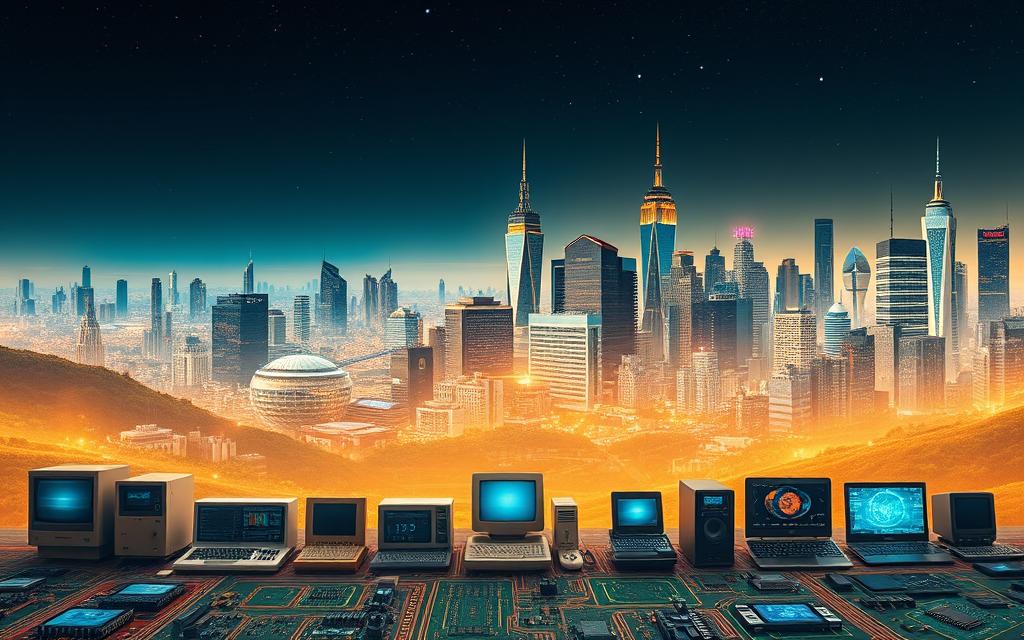Applications in Computer Science: What They Are & How They Work
Computer science applications transform complex theories into practical software solutions. These programs power everything from personal devices to enterprise systems. They drive modern digital ecosystems and technological innovation.
Software applications have evolved dramatically since computing’s early days. The ENIAC in 1945 marked the beginning of this journey. Today’s AI-driven systems showcase how far we’ve come1.
Modern applications span various sectors, enabling new problem-solving approaches. Python has become vital for developing intelligent systems. These systems analyse vast datasets and generate useful insights1.
The global tech market reflects this transformation. AI technologies are projected to reach $390.9 billion by 20251. This growth highlights the increasing importance of computer science applications.
The demand for skilled professionals in this field is soaring. Software development roles are expected to grow 22% by 20301. This increase reflects the growing complexity of technological innovation.
Professionals in this field can expect good pay. Data scientists, for example, earn an average of £120,000 annually1. These salaries reflect the value of expertise in computer science applications.
Computer science applications have intricate components and a rich history. They offer transformative potential across various industries. Let’s explore these fascinating aspects further.
What is an Application in Computer Science?
Computer applications are clever software solutions for specific tasks on digital devices. They’re key to modern computing, changing how we use technology in various fields2.
Applications come in many forms, from simple tools to complex systems. They include word processors, database programs, web browsers, image editors, and communication platforms.
- Word processors
- Database programs
- Web browsers
- Image editors
- Communication platforms
Core Software Components
Every computer application has complex software parts working together smoothly. These parts talk to the computer’s operating system to use hardware like memory and storage2.
Creating these applications needs advanced programming languages and clever algorithms.
Diverse Application Types
Applications can be sorted into different groups:
- Native applications: Designed for specific hardware platforms
- Web applications: Accessed through web browsers
- Hybrid applications: Combining web and native technologies
Programming Languages in Application Development
Various programming languages are vital for making sophisticated applications. Web applications often use JavaScript, CSS, and HTML2.
The choice of language depends on what the application needs and where it will be used3.
Modern software development requires a nuanced understanding of various programming languages and their unique capabilities.
Computer applications keep changing, with cloud computing and mobile tech leading the way. These advances are driving new ideas in software development3.
Evolution and History of Computer Applications
Mathematical innovations paved the way for technological advancements in computer history. The abacus, developed in ancient Sumer, was one of the earliest computational tools4. These primitive devices showcased humanity’s desire to simplify complex maths.

Charles Babbage’s Analytical Engine, designed in 1837, marked a pivotal moment in computational thinking5. This theoretical machine could perform complex calculations. It’s often seen as the forerunner to modern computers4.
- Early computational tools demonstrated mathematical innovation
- Mechanical computing devices expanded mathematical capabilities
- Binary systems emerged as critical technological foundations
The mid-20th century saw rapid growth in computer science. Electronic digital computers like the Atanasoff–Berry and Konrad Zuse’s Z3 transformed computational abilities4. Programming languages such as FORTRAN and COBOL enabled more sophisticated interactions with computers5.
Personal computers in the 1970s made computational power widely available5. Microprocessors and graphical user interfaces made computers more accessible to the general public6.
The history of computer applications is a testament to human ingenuity and technological progression.
The internet revolutionised information exchange in the late 20th century5. This global network transformed communication, commerce, and social interactions. It set the stage for today’s digital ecosystems.
Key Industries Transformed by Computer Applications
Computer applications are reshaping how businesses operate and deliver services. These software solutions drive innovation and efficiency across multiple sectors. They’ve become essential for digital transformation in various industries.
Industry applications are creating significant changes in many professional fields. Their impact goes beyond traditional tech boundaries, reshaping various sectors.
Financial Services and Banking Applications
Financial institutions now use advanced computer applications for better operations. Data analytics and risk management systems have improved decision-making processes significantly.
Financial analysts’ roles have grown more important due to these tech changes. Their average annual salary is about £80,000, with a 9% job growth forecast.
- Advanced trading platforms
- Real-time risk assessment tools
- Automated investment algorithms
Healthcare and Medical Systems
Computer applications have greatly advanced medical technology. Electronic health records, diagnostic tools, and telemedicine platforms are improving patient care.
UCL MotionInput v3 shows how tech can help people with mobility issues. It allows computer interaction through voice commands and gestures.
| Healthcare Technology | Impact |
|---|---|
| Telemedicine Platforms | Remote Patient Consultation |
| AI Diagnostic Tools | Enhanced Disease Detection |
Business Process Automation
Modern businesses rely on ERP systems and CRM software. These sector-specific solutions streamline operations and boost productivity. They also help reduce human error in various business processes.
Entertainment and Gaming Industry
Computer applications have transformed entertainment, creating immersive experiences. Advanced content creation tools and gaming platforms push technological boundaries. Streaming services and interactive media continue to evolve, offering new ways to engage.
Computer applications are driving innovation across industries. They’re not just tools, but fundamental catalysts for change7.
Modern Application Development and Technologies
App development is rapidly evolving, driven by new technologies reshaping software engineering. Organisations are adopting innovative approaches for more dynamic and efficient applications8. By 2025, 80% of non-IT professionals may develop apps using low-code and no-code tools8.
Contemporary software engineering has introduced several groundbreaking methodologies:
- Cloud-native development leveraging microservices
- DevOps practices for accelerated delivery
- Continuous Integration/Continuous Delivery (CI/CD)
Low-code and no-code platforms have democratised app development. They enable people with limited tech skills to create sophisticated digital solutions8. These platforms are changing how organisations approach software creation9.
Artificial intelligence is transforming modern app development. AI tools now generate code, perform automated testing, and monitor performance9. Generative AI produces code snippets from natural language prompts, boosting developer productivity9.
Custom web applications can cost between £50,000 and £250,000 to develop. This reflects the complexity and importance of modern software solutions8. As businesses digitalise, app development remains crucial for future-proofing and delivering exceptional user experiences8.
The Role of Programming Languages in Application Development
Programming languages are vital for software development. They bridge the gap between developers and computers. Coding languages transform complex ideas into functional software solutions10.
Several key languages drive modern software development:
- Python: Renowned for its simplicity and versatility in web development, data analysis, and artificial intelligence10
- JavaScript: A core technology powering interactive web experiences11
- Java: Offering cross-platform compatibility through its virtual machine12
Developers must weigh multiple factors when choosing a programming language. Performance, scalability, and ecosystem support are crucial considerations10. JavaScript leads web development, with 62.3% of developers using it11.
Programming is not just about writing code, but about solving complex problems creatively.
Programming paradigms have evolved, transforming software development. Developers now have diverse strategies for creating robust applications12. Collaboration, innovation, and communication remain essential in this dynamic field11.
Challenges and Future Trends in Computer Applications
Computer applications are changing fast, driven by new tech challenges and innovations13. As digital tech grows, professionals must adapt to complex shifts reshaping industries14.
- Artificial Intelligence integration across sectors13
- Quantum computing advancements14
- Cybersecurity innovations13
- Edge computing development14
The global tech scene offers amazing growth chances. The AI market could hit $390.9 billion by 2025, showing huge growth14.
Quantum computing investments are rising fast. Big tech firms like Google and IBM are leading major research efforts14.
Tech challenges remain crucial. Cyber threats keep evolving, needing smart defence systems. Experts must learn to solve tricky computing issues13.
Low-code platforms are on the rise. They make it easier for non-coders to build apps13.
Future software development will focus on:
- Enhanced data processing capabilities
- Machine learning integration
- Energy-efficient computing solutions14
Innovation defines the future of computing, challenging traditional technological boundaries.
Conclusion
Computer applications have transformed our technological landscape. They’ve driven advancements across multiple sectors, reshaping industries, communication, and professional practices15. Software innovation has become synonymous with technological progress.
The global application software market is set to exceed $500 billion by 202515. Specialised software solutions are increasingly tailoring themselves to specific business needs. About 75% of businesses report significant operational improvements through targeted application software15.
Custom software development is growing rapidly. This reflects organisations’ desire for personalised technological solutions15. As digital transformation accelerates, computing professionals are seeing unprecedented opportunities.
Computing jobs are among the highest-paid careers. Computer science experts report substantial job satisfaction. The ongoing evolution of application technologies suggests an exciting future.
Computer applications are more than just technological tools. They’re catalysts for progress, enabling human potential and driving societal advancement. Continued investment in research and skilled professionals ensures a bright technological future.
FAQ
What exactly is a computer application?
How do different programming languages impact application development?
What are the most significant industries transformed by computer applications?
What are the current trends in application development?
How do applications interact with operating systems?
What cybersecurity challenges do modern applications face?
What role does artificial intelligence play in modern applications?
How are mobile and web applications different?
What emerging technologies are likely to influence future application development?
How do cloud technologies impact modern application development?
Source Links
- https://www.spiceworks.com/tech/tech-general/articles/computer-science/
- https://www.techtarget.com/searchsoftwarequality/definition/application
- https://en.wikipedia.org/wiki/Application_software
- https://en.wikipedia.org/wiki/History_of_computer_science
- https://www.computersciencetutorgcse.co.uk/introduction-to-computer-science-history-of-computer-science
- https://link.springer.com/chapter/10.1007/978-3-031-45304-5_3
- https://www.nobledesktop.com/learn/computer-science/industries-and-professions
- https://kissflow.com/application-development/what-is-application-development/
- https://www.ibm.com/think/topics/software-development
- https://amorserv.com/insights/introduction-to-programming-languages
- https://www.coursera.org/articles/what-is-programming
- https://www.britannica.com/science/computer-science/Programming-languages
- https://kahedu.edu.in/the-future-of-computer-applications-predictions-and-possibilities/
- https://www.learningroutes.in/blog/10-future-computer-applications
- https://www.simplilearn.com/tutorials/programming-tutorial/what-is-application-software







